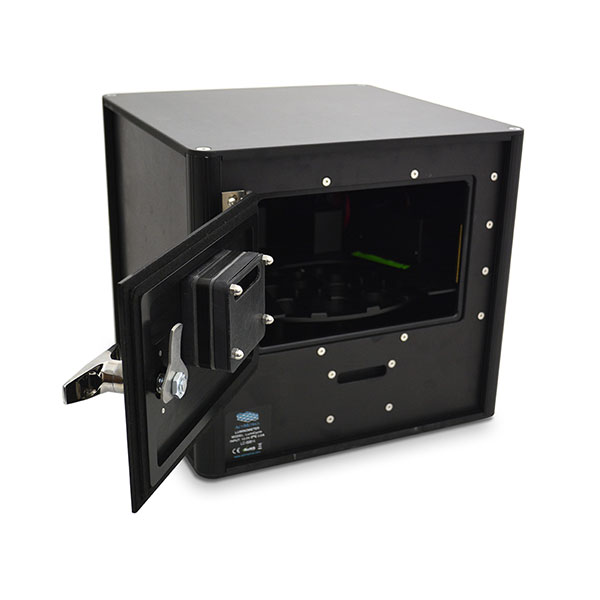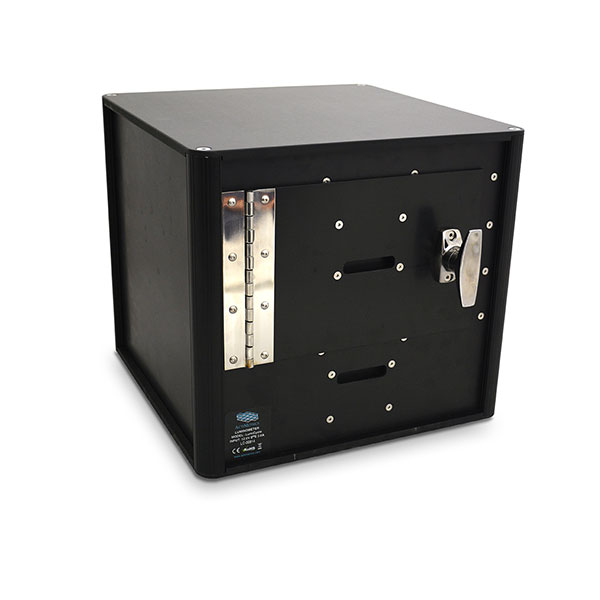

LumiCycle performs high-throughput luminometry on self-luminous tissues, such as those from transgenic animals containing the luciferase gene.
LumiCycle performs high-throughput luminometry on self-luminous tissues, such as those from transgenic animals containing the luciferase gene. The system is equipped with 4 photon-counting photomultiplier tubes, each selected for low dark counts and high sensitivity in the green portion of the spectrum at which luciferase emits light. 32 tissue samples, each in a 35 mm Petri dish, can be counted at one time. 8 dishes share each photodetector using a turntable device that alternately brings each dish under the detector, one at a time.
The LumiCycle apparatus fits inside a standard incubator. An internal fan circulates the incubator air to maintain the proper temperature within the chamber. The temperature is therefore as stable as the incubator can make it. The turntable and photon counting are fully automated. System setup and operation is straightforward. Online help files are included with the software.
Two-colour option. With the 2-colour adaptation, coloured filters can be placed on 2 of the photomultipliers so that 16 samples can be recorded simultaneously in 2 different colours. To create the image on the right, fibroblasts were transfected with Bmal-Nluc and Per2-Fluc, and recorded with a 550 nm long-pass filter on one PMT and 500 nm short-pass filter on the other. Optical filters can be easily changed by the user, or they can be removed for recording in the standard, non-colour mode.
In addition to its high-precision photon counting hardware, LumiCycle has the most flexible and easy-to-use software for the collection and analysis of circadian rhythms in luminometry data.
Alcántara-Alonso, V., Dallmann, R., Lehnert, H., de Gortari, P., & Grammatopoulos, D. K. (2023). CRH-R2 signalling modulates feeding and circadian gene expression in hypothalamic mHypoA-2/30 neurons. Frontiers in Endocrinology, 14. https://doi.org/10.3389/FENDO.2023.1266081/FULL
Draijer, S., Timmerman, R., Pannekeet, J., van Harten, A., Farshadi, E. A., Kemmer, J., van Gilst, D., Chaves, I., & Hoekman, M. F. M. (2023). FoxO3 Modulates Circadian Rhythms in Neural Stem Cells. International Journal of Molecular Sciences 2023, Vol. 24, Page 13662, 24(17), 13662. https://doi.org/10.3390/IJMS241713662
Graniczkowska, K. B., Paulose, J. K., & Cassone, V. M. (2023). Circadian regulation of metabolic, cell division, and cation transport promoters in the gastrointestinal bacterium Klebsiella aerogenes. Frontiers in Microbiology, 14. https://doi.org/10.3389/FMICB.2023.1181756/FULL
Hesketh, S. J., Sexton, C. L., Wolff, C. A., Viggars, M. R., & Esser, K. A. (2023). Early morning run-training results in enhanced endurance performance adaptations in mice. BioRxiv. https://doi.org/10.1101/2023.09.18.557933
Katoku-Kikyo, N., Lim, S., Yuan, C., Koroth, J., Nakagawa, Y., Bradley, E. W., & Kikyo, N. (2023). The circadian regulator PER1 promotes cell reprogramming by inhibiting inflammatory signaling from macrophages. PLOS Biology, 21(12), e3002419. https://doi.org/10.1371/JOURNAL.PBIO.3002419
Mawatari, K., Koike, N., Nohara, K., Wirianto, M., Uebanso, T., Shimohata, T., Shikishima, Y., Miura, H., Nii, Y., Burish, M. J., Yagita, K., Takahashi, A., Yoo, S. H., & Chen, Z. (2023). The Polymethoxyflavone Sudachitin Modulates the Circadian Clock and Improves Liver Physiology. Molecular Nutrition & Food Research, 67(9), 2200270. https://doi.org/10.1002/MNFR.202200270
Ting, I. J., Psomas, A., Skene, D. J., & van der Veen, D. R. (2023). Reduced glucose concentration enhances ultradian rhythms in Pdcd5 promoter activity in vitro. Frontiers in Physiology, 14. https://doi.org/10.3389/FPHYS.2023.1244497/FULL
| Tissue holders | 35 mm dishes (Falcon) |
| Capacity | 32 dishes |
| Detectors | 4 Photomultiplier tubes (photon counting mode) Each tube records alternately from 8 dishes |
| Dark counts | <10/sec @ 20 deg. C 50/sec typical @ 35 deg. C |
| Optical Filters for color separation |
Diameter: 25 mm Thickness: 3 mm Long Pass (from Edmund Optical) Short Pass (from Edmund Optical) |
| Operating temperature | Up to 37 deg. C – ambient humidity (as set by incubator or environmental room) |
| Dimensions | 14″ W x 13.5″ H x 14″ D (35.5 x 34.3 x 35.5 cm) Front loading |
| Count period | 10 s – 1 hr program selectable |
| System requirements | Windows 7/8/10 1 USB port 1280 x 1024 resolution monitor recommended |
| Analyses | Actogram Periodogram Spectral (sinusoidal fit and damped sinusoidal fit) Phase shift (double sinusoidal fit to defined periods) Baseline subtraction (low-order polynomial) |
| Warranty | One year, parts and labor |
ClockLab’s data collection application runs on Windows operating systems and performs many functions that are not usually incorporated in similar systems.
A widely used stand-alone program for the analysis of circadian rhythms. It can read and analyze records obtained from almost any circadian data collection system, including the ClockLab data collection program.

